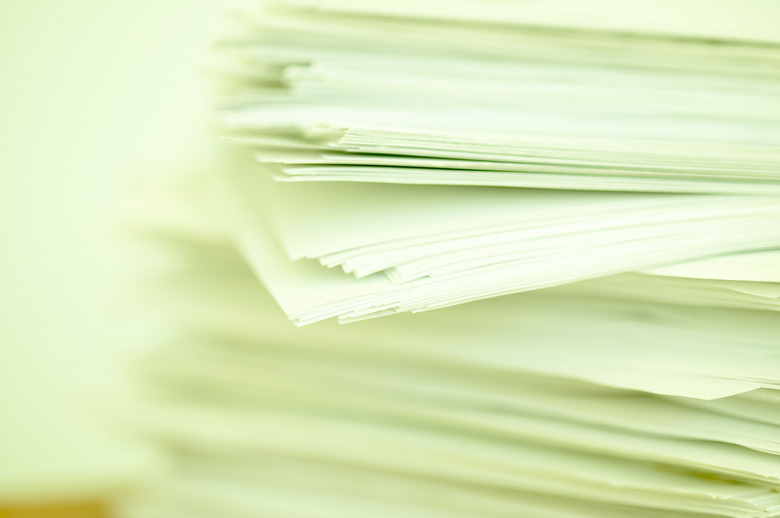What Are Some Chemical Reactions Used In The Manufacturing Of Paper?
Paper may seem like a commonplace and simple product, but its manufacture is actually more complicated than most consumers probably realize. A key reason for this is the chemistry of papermaking. Through a series of reactions and physical processes, the chemicals used in the paper industry turn brown wood chips into a glossy white sheet you can hold in your hand. Two of the key chemical reactions involved are bleaching and the Kraft process.
Kraft Process
Kraft Process
Wood is a complex mixture composed primarily of a polymer called cellulose. The cellulose fibers in wood are bound together by another polymer called lignin. Paper makers must remove the lignin from the wood pulp. To accomplish this, one of the main chemical reactions used in industry is the Kraft process, in which wood chips are combined with a mixture of sodium hydroxide and sodium sulfide in water at high temperature and pressure. Under these highly basic conditions, the negatively charged sulfide ions react with the lignin polymer chains to break them down into smaller subunits so the cellulose fibers are freed up for further use.
Alternative Reactions
Alternative Reactions
Although Kraft pulping is by far and away the most popular process, some manufacturers use other approaches for removing lignin. One such alternative is acid sulfite pulping, where a mixture of sulfurous acid and either sodium, magnesium, calcium or ammonium bisulfite in water dissolves the lignin to free up the cellulose fibers. As with Kraft pulping, high temperatures and pressures are required. Yet another alternative is neutral sulfite semichemical pulping, where the chips are mixed with a mixture of sodium sulfite and sodium carbonate in water and cooked. Unlike the others, this process only removes a portion of the lignin, so after pulping the chips must be shredded mechanically to remove some of the remaining polymer.
Bleaching Chemistry
Bleaching Chemistry
No matter which process a manufacturer chooses for pulping, some of the lignin is still left intact, and this remaining lignin generally gives the pulp a brown color. Manufacturers remove this residual lignin and turn the pulp white through another chemical process called bleaching. In this process, an oxidizing agent — a chemical that oxidizes lignin by either adding oxygen atoms to it or removing electrons — is combined with the wood pulp to destroy the remaining lignin. Bleaching tends to be more selective than pulping; unlike pulping, which also destroys a small fraction of the cellulose, bleaching primarily eliminates lignin.
Bleaching Chemicals
Bleaching Chemicals
Common bleaching chemicals include chlorine, chlorine dioxide, oxygen, hydrogen peroxide, ozone and sodium hypochlorite, the active ingredient in household bleach. Even though the mechanism of each reaction is different, all of these are oxidizing agents that will oxidize the lignin in the pulp. Chlorine, chlorine dioxide and hydrogen peroxide are the most selective of these agents, meaning they have less tendency to react with cellulose and other desirable parts of the mixture. Aside from their ability to remove lignin, chlorine, chlorine dioxide and sodium hypochlorite are also superior in their ability to remove dirt particles, which is another important factor for manufacturers to consider.
Other Reactions
Other Reactions
Once it's been pulped and bleached, the pulp is fed into a series of machines that will alter it through physical rather than chemical processes to make it into a sheet. Depending on what kinds of properties they want their product to have, manufacturers employ a diverse array of other chemical reactions called sizing, retention and wet strength processes that impart moisture resistance, bind the smaller fibers in or alter the product so it is less likely to fall apart when wet. Typically these processes involve one of a variety of polymers that will bind to the cellulose fibers in the finished product. Wet-strength processes, for example, typically combine the cellulose fibers with polyamido-amine-epichlorohydrin resins which react with the fibers to crosslink them so they are less likely to fall apart in water.
Cite This Article
MLA
Brennan, John. "What Are Some Chemical Reactions Used In The Manufacturing Of Paper?" sciencing.com, https://www.sciencing.com/chemical-reactions-used-manufacturing-paper-13973/. 9 October 2018.
APA
Brennan, John. (2018, October 9). What Are Some Chemical Reactions Used In The Manufacturing Of Paper?. sciencing.com. Retrieved from https://www.sciencing.com/chemical-reactions-used-manufacturing-paper-13973/
Chicago
Brennan, John. What Are Some Chemical Reactions Used In The Manufacturing Of Paper? last modified August 30, 2022. https://www.sciencing.com/chemical-reactions-used-manufacturing-paper-13973/
